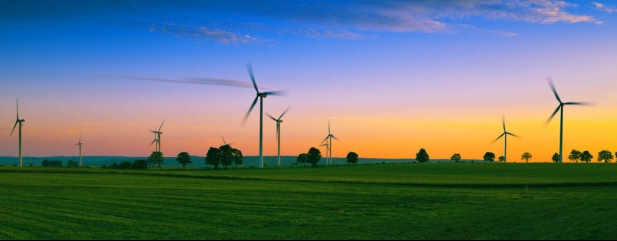Archived article
Please note that tax, investment, pension and ISA rules can change and the information and any views contained in this article may now be inaccurate.
SSE is a great way to play the green revolution

Utility SSE (SSE) has established an ambitious programme to treble renewable output by 2030 and reach a run-rate of one gigawatt of new assets a year during the second half of the current decade. We think you should buy the shares to take advantage of what should be a profitable journey for investors.

The company plans to invest £7.5 billion in its infrastructure over the next five years enabling the electrification of heat and transport through building smart, flexible local energy grids. The goal is to accommodate 10 million electric cars by 2030.
Analysts at Morningstar estimate that the projects will earn a return on investment of 6.2% a year, above the company’s cost of capital, providing investors with value added growth.
In addition, SSE has committed to paying an annual dividend of 80p per share which the company has said will rise in line with retail price inflation out to 2023, giving savers some inflation protection on top of a handsome yield of 5.2%.

Overall we believe SSE is attractively positioned to play a key role in the UK’s move towards a net zero economy, with both growth and income attributes.
WHAT DOES SSE DO?
The company’s core businesses are its regulated transmission and distribution businesses and the renewables arm which cumulatively contribute the bulk of the firm’s operating profit.
The renewables division generates zero carbon electricity through the construction and operation of large scale onshore and offshore wind farms as well from hydroelectric and pumped-storage assets.
Pumped storage is one of the oldest forms of large hydroelectric energy storage and involves constructing two reservoirs at different heights with gravity providing the source of energy. The advantage of these assets is that they are capable of responding to large load changes (or changes in energy requirements) within seconds.
The firm is planning to develop the first new pumped storage facility in 30 years which, if granted government support should provide clean power for three million homes for up to 24 hours.
SSE gets paid through several mechanisms, including supplying electricity to the wholesale energy market, various ancillary services, power purchase agreements, the capacity market and state subsidies.
The regulator determines the rate of return that the company can earn on its investments. Additional earnings can be made through efficient delivery of investment and targeted, performance-related incentives.
SSEN Transmission owns, operates and maintains the electricity transmission network in the north of Scotland for large electricity demand customers and essentially all customers across the UK.
SSEN Distribution owns, operates and maintains the electricity networks in the north of Scotland and central southern England for homes, businesses and service providers that are connected to the network.

MORE FOCUSED GROUP
The company has made good progress on executing its plan to reduce the carbon footprint of the group by divesting non-core assets and reinvesting in renewable projects, so far exceeding its original expectations.
It is on track to raise £2 billion from asset sales after the sale of two energy-to-waste projects which raised £995 million in cash and the sale of a 25% stake in Walney Offshore Wind Farm and a one-third stake in meter asset provider MapleCo.
Altogether the agreed disposals are expected to yield £1.5 billion in proceeds with more to come from the sale of the minority company’s stake in SGN, the gas distribution company that serves homes and workplaces in Scotland, Northern Ireland and the south of England.
The proceeds will help shore up the balance sheet and allow the release of capital which can be deployed to create value from significant growth opportunities from renewable energy.
The company said at its recent results (26 May) that it is currently leading construction of more offshore wind than anyone in the world.
SSE has adopted a partnership model to developing new projects which it believes provides better returns than those achieved by purely financial backers, because it effectively de-risks the process.
The company reckons its partnership approach with large firms such as Norway’s Equinor and French energy group Total allows developer premiums to be secured which typically yield higher values when stakes are sold down.
Developer profits of £226 million were made from the sale of a 51% stake in the Seagreen offshore windfarm and a 10% stake in Scotland’s biggest offshore Dogger Bank.
As well as avoiding a large increase in net debt, the approach appeals to a range of partners with different risk appetites who prefer exposures to different stages of the project cycle.
Intriguingly, management is considering adopting the same approach for the transmission and distribution businesses, which will involve selling minority stakes.
SSE is well financed, and its key financial objective is to maintain net debt to EBITDA (earnings before interest, taxes, depreciation, and amortisation) in the range of between 4.5 and five times.
The company is due to provide an update on its renewable energy growth plans in November. Time to get aboard now before the opportunities are fully reflected in the shares.
Important information:
These articles are provided by Shares magazine which is published by AJ Bell Media, a part of AJ Bell. Shares is not written by AJ Bell.
Shares is provided for your general information and use and is not a personal recommendation to invest. It is not intended to be relied upon by you in making or not making any investment decisions. The investments referred to in these articles will not be suitable for all investors. If in doubt please seek appropriate independent financial advice.
Investors acting on the information in these articles do so at their own risk and AJ Bell Media and its staff do not accept liability for losses suffered by investors as a result of their investment decisions.

 magazine
magazine








